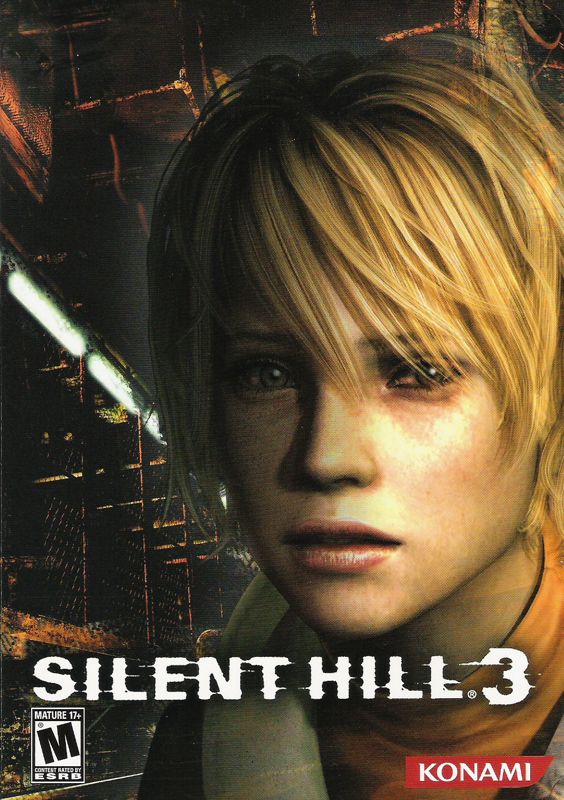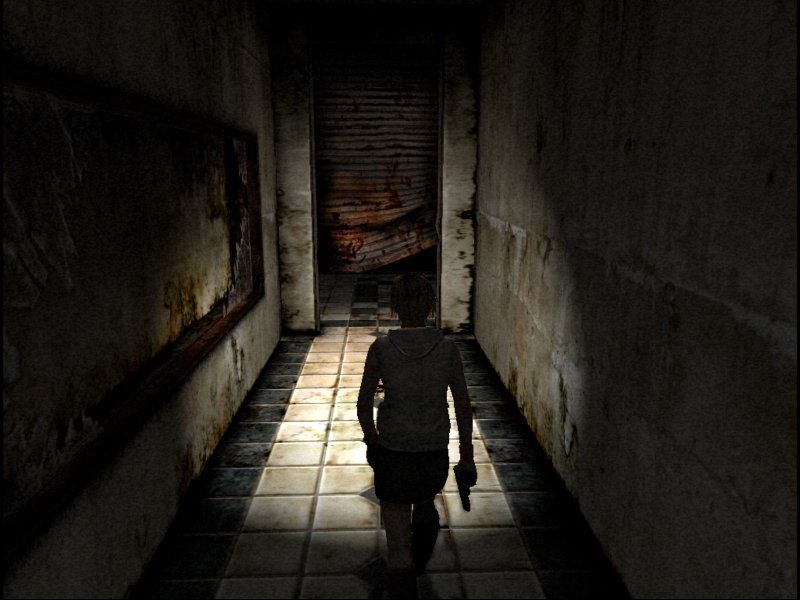Retro Replay Review
Gameplay
Silent Hill 3 strikes a careful balance between exploration, combat, and puzzle-solving, keeping players on edge as they guide Heather through both mundane and nightmarish environments. City streets give way to rusted subway tunnels, decrepit hospitals, and an abandoned amusement park, each area packed with hidden notes, cryptic riddles, and logic-based puzzles. Progression rarely feels linear, as backtracking and revisiting previously safe zones under “Otherworld” conditions can reveal new pathways or items essential for advancing the plot.
(HEY YOU!! We hope you enjoy! We try not to run ads. So basically, this is a very expensive hobby running this site. Please consider joining us for updates, forums, and more. Network w/ us to make some cash or friends while retro gaming, and you can win some free retro games for posting. Okay, carry on 👍)
Combat in Silent Hill 3 is more pronounced than in its predecessors, offering Heather a diverse arsenal that ranges from improvised melee tools like knives and pipes to firearms such as handguns, shotguns, and submachine guns. Ammunition and healing items are scarce, reinforcing a tense atmosphere in which every shot counts. Players must carefully manage their resources, choosing when to engage grotesque creatures head-on, sidestep attacks for strategic positioning, or simply flee to preserve health.
Puzzles are integrated organically into the environment, encouraging close inspection of letters, diagrams, and environmental clues. Many challenges require the player to decipher elaborate symbols or use specific items in creative ways, rewarding attention to detail. The risk-reward dynamic is heightened when solving puzzles in “Otherworld” sequences—timed environmental shifts that can trap the unwary if they linger too long.
The user interface remains minimalist, with a pause-based inventory screen and red glyphs marking save points. Difficulty settings for combat and puzzles can be tweaked independently, allowing veterans to crank up the tension while newcomers can ease into the game’s more intricate riddles. Overall, the gameplay loop is tight, immersive, and designed to keep players perpetually uncertain of what lurks around the next corner.
Graphics
Silent Hill 3 employs a gritty, atmospheric visual style that complements its horror themes. The fog-shrouded town of Silent Hill is rendered with muted colors and grainy textures, evoking a sense of decay and desolation. Details in the “normal” world—flickering street lamps, peeling posters, and abandoned cars—create an unsettling calm before the storm.
The transition to the “Otherworld” remains one of the game’s most striking visual achievements. Walls ooze with rust and blood, tiled floors are cracked and stained, and corroded pipes drip incessantly. Lighting effects grow more dramatic as flickering bulbs cast long shadows, and sudden bursts of red highlight key environmental hazards. These shifts feel organic, as though the world itself is warping around Heather’s presence.
Character models and creature designs are grotesque yet detailed. Heather’s animation is fluid, from her cautious walk to her recoil when firing a shotgun. Enemies range from shambling humanoids with exposed sinew to nightmarish amalgamations of flesh and metal. Although polygon counts and texture resolution reflect the hardware limitations of the original release, the art direction compensates, delivering a palpable dread that few modern horror titles could replicate without sacrifice to visual fidelity.
Complementing the visuals, dynamic camera angles heighten suspense, often cutting to jittery close-ups or low-angle shots that make corridors appear impossibly long. Occasional fog and particle effects obscure distant details, forcing reliance on sound and intuition. Together, these graphical and cinematic techniques forge a deeply immersive world that rewards players who seek out every nook and cranny.
Story
Silent Hill 3 picks up threads from the original game, zooming in on Heather Mason—a seemingly ordinary teenager whose routine shopping trip spirals into horror. An unsettling encounter in a mall leads her down a rabbit hole of shifting realities, grotesque monsters, and terrifying cult rituals. From the outset, the narrative nails a tone of isolation, as Heather grapples with questions about her identity and the hidden forces pulling her into Silent Hill’s grasp.
The script unfolds through a blend of in-engine cutscenes and fully voiced dialogue sequences. Heather’s interactions with allies, such as investigative reporter Douglas Cartland, and antagonists, like the zealous cult members, are taut and purposeful. The game refrains from excessive exposition, instead doling out lore through scattered notes, tape recordings, and environmental storytelling. This method keeps the mystery front and center and encourages players to piece together the truth themselves.
The presence of a sinister cult intent on using Heather in a dark ritual lends an epic, almost mythic quality to the plot. Themes of rebirth, guilt, and personal trauma weave through each chapter, culminating in confrontations that force Heather to confront both her past and a looming prophecy. The story’s pacing tightens as she delves deeper into the Otherworld, with revelations arriving just when the tension threatens to plateau, ensuring a steady escalation of dread and emotional stakes.
While fans of Silent Hill 2 may notice parallels in tone and thematic concerns, Silent Hill 3 tells its own complete story, rich with symbolism and personal tragedy. Heather’s journey feels both intimate and grand in scope—an odyssey through fear, self-discovery, and the lengths one will go to reclaim agency over a haunted past.
Overall Experience
Silent Hill 3 remains a gold standard for survival horror, seamlessly blending atmospheric exploration, resource-driven combat, and mind-bending puzzles. The game’s deliberate pacing allows tension to build organically, rewarding patient players who dare to search every corner. Moments of respite in the “normal” world make each plunge into the Otherworld feel all the more harrowing.
The combination of haunting visuals, oppressive sound design, and a mature, emotionally charged narrative creates an experience that lingers long after the credits roll. Heather Mason’s plight is believable and compelling, driven by a soundtrack that layers ambient drones with mournful piano motifs. Even the simplest sound cues—footsteps echoing in an empty room or distant whispers—can trigger genuine unease.
Some modern players might find the dated controls or fixed camera angles challenging, but these design choices are intrinsic to the game’s identity. Adapting to the slower movement and limited save points cultivates a greater appreciation for each encounter and puzzle. For newcomers, adjustable difficulty settings and ample in-game documentation smooth out the learning curve without diluting the horror.
Ultimately, Silent Hill 3 stands as a masterclass in crafting dread through atmosphere, storytelling, and game mechanics. Its ability to evoke primal fears while delivering a deeply personal tale makes it essential for fans of psychological horror and anyone seeking an unforgettable journey into the unknown.
 Retro Replay Retro Replay gaming reviews, news, emulation, geek stuff and more!
Retro Replay Retro Replay gaming reviews, news, emulation, geek stuff and more!









Reviews
There are no reviews yet.